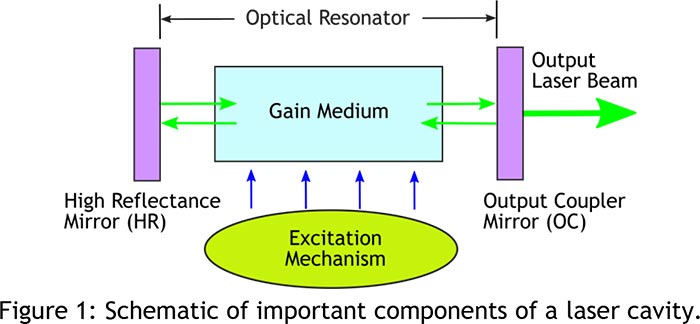Laser
A Laser, an acronym for "Light Amplification by Stimulated Emission of Radiation" is a powerful device that produces an intense and highly focused beam of light. They have found applications in a wide range of fields, from telecommunications and manufacturing to medicine and scientific research.
Key Components:

- Gain Medium: The heart of a laser is the gain medium (Fig. 1), a material capable of amplifying light through a process called stimulated emission. Common gain mediums include crystals, gases (like CO2), liquid and solid dyes and semiconductors.
- Energy Source: An external energy source (excitation mechanism in Fig. 1), such as a flash lamp or electrical discharge, excites the atoms or molecules within the gain medium, pushing them into higher energy states.
- Optical Resonator: The gain medium is placed between two mirrors, forming an optical resonator. One mirror is fully reflective (HR in Fig. 1), while the other (OC in Fig. 1) allows a part of the light to escape. This arrangement encourages the stimulated emission of photons and confines them to a specific path, creating a coherent and collimated laser beam.
Properties of Lasers:
- Coherence: Laser light is highly coherent, meaning its waves are in phase with each other. This coherence results in a well-defined beam with minimal divergence, making lasers ideal for precision applications.
- Monochromaticity: Lasers emit light of a single, specific wavelength, giving them distinct colours. This property is crucial in various scientific, medical, and industrial processes.
- Collimation: Laser beams are highly collimated, meaning they spread minimally over distance. This property enables laser light to travel long distances with minimal dispersion.
- Intensity: Lasers can produce extremely high-intensity light, often in the form of pulses. This intensity makes lasers invaluable in cutting, welding, and drilling materials.
Applications:
- Medical: Lasers are used in surgery (laser surgery), dermatology (removing tattoos and skin imperfections), and ophthalmology (correcting vision).
- Telecommunications: Optical fibers and laser diodes enable high-speed data transmission over long distances in telecommunications networks.
- Manufacturing: Lasers are used for cutting, engraving, welding, and 3D printing in industries ranging from automotive to electronics.
- Scientific Research: Lasers are essential tools for spectroscopy, microscopy, and studying atomic and molecular interactions.
- Defense: They have applications in target designation, range finding, and directed-energy weapons.
- Entertainment:Lasers are used in laser light shows and optical displays.
- Environmental Monitoring: They help measure atmospheric pollutants and greenhouse gases with high precision.
The landscape of laser technology has witnessed remarkable developments across a spectrum of investigations. Some of the applications of interest include, the progress in Carbon dioxide (CO2) and Carbon monoxide (CO) lasers that has spurred extensive exploration of their properties and applications. Resonance Ionization Mass Spectrometry (RIMS) employing indigenous Time-of-flight Mass Spectrometers (ToFMSs) and commercial Nd:YAG pumped Dye lasers that are tunable has significantly enriched spectroscopy of atomic species. Innovative laser-based instruments designed for precision measurements, including a Laser Scan Dia Gauge for diameter, Laser Surf Check for surface roughness, Laser Velocity Meter for projectile velocity, and Laser Vibrometer for non-contact surface vibration measurement from a 200 mm distance.
The Diode Laser systems find utility in communication, atom cooling, and quantum interference. Innovations extend to narrow linewidth single mode dye lasers with demanding applications in medical isotope separation. Nd:YAG laser-based LIBS offers material insights, while high-repetition rate optical parametric oscillator (OPO) and all solid-state tunable lasers broaden spectroscopic capabilities. Ultrafast (picosecond) lasers enable Micro-structuring studies in conjunction with a pulsed laser deposition (PLD) system. Laser dye synthesis yields sensitive biosensors, and also suitable dye for dye lasers. Hollo cathode discharge lamps (HCDLs) aid opto-galvanic technique based solid sample spectroscopy, collectively exemplifying laser technology's diverse impact.
Lasers are a transformative technology with a vast array of applications, driven by their unique properties of coherence, monochromaticity, and intensity. Their impact continues to grow across industries, shaping our modern world in numerous ways, from the internet to medical breakthroughs, nuclear fusion and beyond. As research and development in laser technology advance, new applications and innovations are on the horizon, promising a future where lasers play an even more significant role in our lives.















